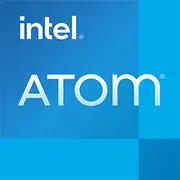Intel Atom E3815

Intel Atom E3815: Minimum Power, Maximum Energy Efficiency. Who Will Benefit in 2025?
Introduction
In an era where Apple M3 and AMD Ryzen 8000 processors demonstrate teraflops of performance, the Intel Atom E3815 appears outdated. However, this chip remains relevant in niche devices. Let's explore who it might be useful for in 2025.
1. Architecture and Process Technology: Modest Specs for Basic Tasks
Cores, Threads, and Frequencies
The Atom E3815 (codenamed Bay Trail-I) is a single-core processor with one thread, manufactured using a 22nm process. Its base frequency is 1.46 GHz, and it lacks a turbo mode. The Silvermont architecture, introduced in 2013, is optimized for minimizing power consumption rather than achieving high performance.
Integrated Graphics
The built-in GPU is the Intel HD Graphics (Gen7), featuring 4 execution units (EU) and a frequency of up to 400 MHz. This solution can handle display output on two screens (up to 1920x1080) and decode H.264/MPEG-4 video, but it is unsuitable for modern gaming or rendering.
2. Power Consumption and TDP: Ideal for Passive Cooling
The processor's TDP is 5 Watts, allowing it to operate without a fan. This is a key advantage of the chip:
- Suitable for compact devices (for example, mini-PCs the size of a palm).
- Saves battery power — laptops with the E3815 can run for 10-12 hours with a battery capacity of 40-45 Wh.
- Does not require a complex cooling system, reducing the device's cost.
3. Performance: Realistic Expectations
Office Tasks and Web Browsing
- Google Docs, LibreOffice: Comfortable for working with texts and spreadsheets, but scenarios like opening 10+ tabs in a browser at the same time will cause lags.
- Video Calls: Maximum — SD resolution via Zoom; HD streaming is only possible with hardware acceleration.
Multimedia
- Video: Playback of 1080p/30fps (H.264) without problems, but 4K or VP9 are not supported.
- Audio: Podcasts and streaming music — no complaints.
Gaming
Even older games like Half-Life 2 (2004) on low settings will run at around 15-20 FPS. Modern projects are out of reach.
4. Use Cases: Narrow Specialization
The Atom E3815 is relevant for:
- IoT Devices: Smart terminals, information kiosks.
- Budget Netbooks: For example, Chuwi Minibook (2025) priced at $249 — for text entry and reading.
- Industrial PCs: Conveyor management, monitoring systems.
Not Suitable For:
- Working with graphic editors.
- Multitasking (simultaneously running a browser and a messenger already causes slowdowns).
5. Battery Life: Record-breaking, But With Caveats
A laptop with the E3815 (e.g., ASUS Laptop E410MA) with a 42 Wh battery can last up to 14 hours while reading PDFs. However:
- Screen brightness is reduced to 50%.
- Wi-Fi and Bluetooth are disabled for maximum power saving.
Power-saving Technologies:
- Intel SpeedStep — dynamic frequency adjustment.
- C6/C7 States — deep sleep for the core during idle.
6. Comparison with Competitors: Who Else is in the Same Class?
AMD Athlon 3050e (2023)
- 2 cores / 2 threads, 6 W TDP.
- Geekbench 6 Single Core: 298 (+161%).
- Notebook prices start at $350.
Conclusion: The Athlon 3050e is preferable for moderately demanding tasks.
Intel Celeron N4500 (2021)
- 2 cores / 2 threads, 6 W TDP.
- Supports DDR4-2933 (compared to DDR3L-1333 on the E3815).
Conclusion: The Celeron N4500 is 40-60% faster in multi-threaded scenarios.
Raspberry Pi 5 (2023)
- 4 ARM Cortex-A76 cores, 5 W.
- Geekbench 6 Single Core: ~120 (comparable to the E3815).
Conclusion: The Raspberry Pi 5 excels in multitasking and supports modern operating systems.
7. Pros and Cons: Balancing Capabilities
Strengths:
- Low device cost: laptops starting from $199.
- Complete passivity (no noise).
- Supports Windows 10/11 IoT Enterprise.
Weaknesses:
- No support for USB 3.2 Gen 2 (only USB 2.0).
- Maximum 8 GB RAM (more often 4 GB).
- Outdated PCIe 2.0.
8. Device Selection Recommendations
Who Should Buy?
- Schools: laptops for students (text work).
- Businesses: terminals for data collection.
- Travelers: a device for emergency tasks.
What to Look For:
- Screen: An IPS panel with a resolution of 1366x768 — the minimum for comfort.
- Memory: 8 GB RAM (avoid models with 2-4 GB).
- Storage: eMMC 64 GB is outdated; look for options with SATA SSD.
Examples of 2025 Models:
- HP Stream 11 Pro: $229, 11.6" HD, 8 GB/128 GB.
- Digma Eve 14: $199, 14" HD, 4 GB/64 GB (suitable for Linux).
9. Final Conclusion: Niche, But Not Useless
The Intel Atom E3815 is a processor for situations where affordability and energy efficiency matter, rather than power. It is suitable for:
- Corporations deploying hundreds of terminals.
- Parents looking for an "indestructible" laptop for their child.
- Enthusiasts building a media center based on Linux.
Alternative: If your budget allows $300-400, consider the Intel N100 (4 cores, 6 W TDP) or the AMD Ryzen 3 7320U. However, for tasks like "typing and watching YouTube," the Atom E3815 remains one of the most affordable solutions even in 2025.
Basic
CPU Specifications
Memory Specifications
GPU Specifications
Benchmarks
Compared to Other CPU
Share in social media
Or Link To Us
<a href="https://cputronic.com/cpu/intel-atom-e3815" target="_blank">Intel Atom E3815</a>